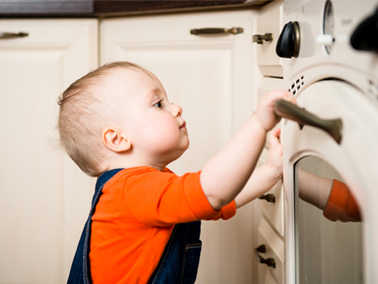Their natural drive to explore means accidents are bound to happen – but there are steps you can take to minimize the risk. Your home can be a dangerous place, and protecting your children is up to you. Here are some ideas to help you provide a healthy, safe environment for your child.
Tips for a child-safe home
The best way to identify hazards around your home is to assess it from your child’s point of view. Get down to their level and look around, up and down. Are there unstable shelves or drawers that can be climbed on and pulled down? Are there small objects within reach that they could choke on? Follow the steps below to prevent accidents from happening!
- Install smoke detectors and make sure that they are in working order at all times.
- Keep cords for electrical appliances out of the reach of children.
- Put childproof locks on cupboards and drawers before children are old enough to open them.
- Block access to stairs with a gate.
- Put a barrier around a gas or wood-burning fireplace or stove to prevent burns.
- Use plastic safety covers over electrical outlets so that children cannot poke their fingers or metal objects into them.
- Dispose of batteries somewhere children don’t have access to.
- Always supervise children at play, especially little ones under the age of 3.
Hazards to avoid
1. Choking on small objects
Young children put things in their mouths and over their heads. Keep small household items like toy parts, coins, paper clips, pen caps, jewellery, screws, buttons, keys, candy, and gum out of the reach of children. In addition, keep plastic bags out of sight as they pose a suffocation hazard.
2.Dangerous furniture
In their drive to climb, children might pull furniture or televisions down on themselves, leading to serious injuries. Every year across Canada, children are hospitalized with injuries caused by a falling television set. Put your TV on a low, stable base and push it back as far as possible. Avoid furniture with legs or wheels, choosing instead a wide base that sits directly on the floor. Anchor furniture to the wall if possible.
3.Loose cords and wires
Blind and curtain cords can strangle babies and young children. Keep the cords out of reach, or consider cordless window coverings. Never put a crib, bed, high chair or playpen near a window or a patio door where a child can reach the blind or curtain cord. Remember to always remove cords and drawstrings from children's clothes such as hoodies, hats, or jackets, as these can be a strangulation hazard. Do not leave excess lengths of electrical cords where a baby can reach.
4.Kitchen and bath hazards
The hot water temperature should not exceed 49°C (120°F). Equip your oven and dishwasher doors with child safety locks. Keep cords for electrical appliances, such as deep fryers, kettles, steam irons and toasters out of the reach of children. Turn pot handles toward the centre of the stove. Children can be hurt or burned if they pull a pot or appliance off a counter. Block access to stoves and fireplaces and keep burning candles out of the reach of children and pets.
5.Household poisons
Keep all chemical and household cleaning products in a locked cupboard out of reach. Ensure that child-resistant closures are working and installed properly, and teach children what the hazard symbols on the containers mean. But don’t stop there. Cosmetics, medication, vitamins, and first-aid treatment products should also be locked safely out of sight. And remember, some indoor plants, like azaleas and rhododendrons, are poisonous. Always keep your local poison control centre phone number handy!
Don’t forget the back yard!
Children often fall while playing outdoors. Consider using shock-absorbing surfacing in your play area, such as sand or shredded wood products. Grass can be hard for little heads. Teach your child to go feet first down a slide and to climb off equipment safely. Check equipment for worn, loose or broken parts. Make sure you put child-proof fences around hot tubs, pools, and decorative ponds. Above all, always keep an eye on your child during playtime!
The information in this article has been adapted from the following web sites. For more on this topic, visit:
Health Canada: Is Your Child Safe? Playtime
Health Canada: Safety Around the House
Health Canada: Furniture, Appliance and Television Safety
CAA Quebec: Young children’s safety in the home: parents and grandparents be responsible

